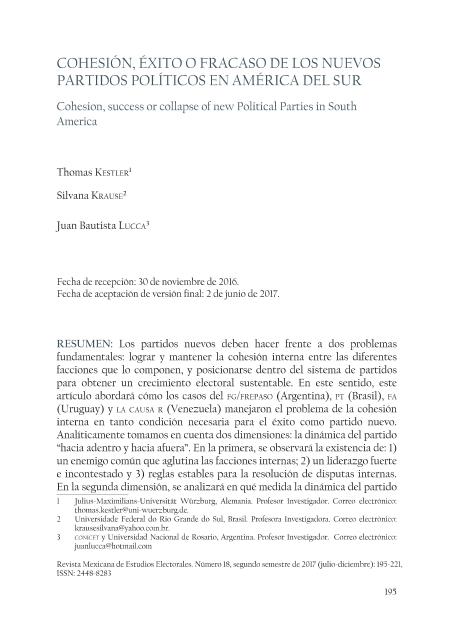Artículo
Los partidos nuevos deben hacer frente a dos problemasfundamentales: lograr y mantener la cohesión interna entre las diferentesfacciones que lo componen, y posicionarse dentro del sistema de partidospara obtener un crecimiento electoral sustentable. En este sentido, esteartículo abordará cómo los casos del fg/frepaso (Argentina), pt (Brasil), fa(Uruguay) y la causa r (Venezuela) manejaron el problema de la cohesióninterna en tanto condición necesaria para el éxito como partido nuevo.Analíticamente tomamos en cuenta dos dimensiones: la dinámica del partido?hacia adentro y hacia afuera?. En la primera, se observará la existencia de: 1)un enemigo común que aglutina las facciones internas; 2) un liderazgo fuertee incontestado y 3) reglas estables para la resolución de disputas internas.En la segunda dimensión, se analizará en qué medida la dinámica del partidohacia afuera refuerza o no la cohesión interna. Con vista a los cuatro casosque observamos suponemos que las reglas estables constituyen un factorprimordial para la cohesión interna y, consecuentemente, para su éxito. In the course of their development, new parties have to confront two fundamental problems: on the one hand they have to achieve and to maintain their internal cohesion between its different factions, and on the other hand, they have to find their place within the party system to grow electorally. The solution of both, interrelated, problems is necessary to open the way to success. On the basis of these considerations, this article addresses the original configuration and development of new partisan forces in South America, with special emphasis on the FG/FREPASO (Argentina), PT (Brazil), AF (Uruguay) and LA CAUSA C (Venezuela), focusing on the question how these parties dealt with the aforementioned problems and especially the problem of internal cohesion that we regard as a necessary condition for a new party’s success. We include two highly interrelated dimensions of analysis that collaborate to study the phenomenon of “party cohesion”: the inward oriented and outward oriented dynamics of each party. In the first dimension, we consider as relevant factors: 1) the existence of a common enemy that serves as a unifying factor, 2) the existence of a strong leadership, and 3) stable rules for the resolution of internal disputes. In the second dimension, we analyze the electoral performance and the dynamics of electoral mobilization. We content that both dimensions interact in furthering or impeding internal cohesion and, by extension, its path towards success.
Cohesión, éxito o fracaso de los nuevos partidos políticos en América del Sur
Título:
Cohesion, success or collapse of new political parties in South America
Fecha de publicación:
12/2017
Editorial:
Sociedad Mexicana de Estudios Electorales A. C.
Revista:
Revista Mexicana de Estudios Electorales
ISSN:
2448-8283
Idioma:
Español
Tipo de recurso:
Artículo publicado
Clasificación temática:
Resumen
Palabras clave:
Cohesión Partidaria
,
Sistema de Partidos
,
Partidos Nuevos
,
América del Sur
Archivos asociados
Licencia
Identificadores
Colecciones
Articulos(CCT - ROSARIO)
Articulos de CTRO.CIENTIFICO TECNOL.CONICET - ROSARIO
Articulos de CTRO.CIENTIFICO TECNOL.CONICET - ROSARIO
Citación
Kestler, Thomas; Krause, Silvana; Lucca, Juan Bautista; Cohesión, éxito o fracaso de los nuevos partidos políticos en América del Sur; Sociedad Mexicana de Estudios Electorales A. C.; Revista Mexicana de Estudios Electorales; 1; 18; 12-2017; 195-221
Compartir




